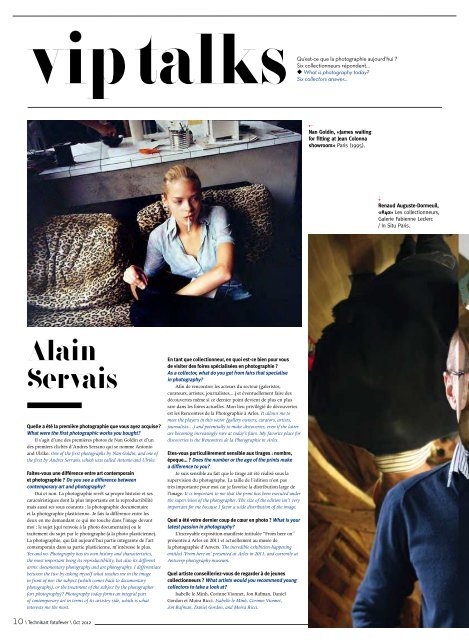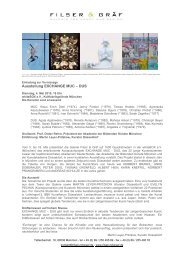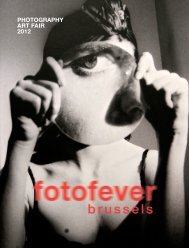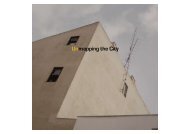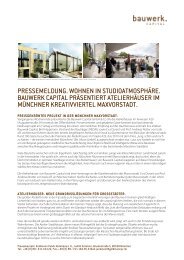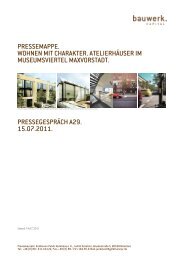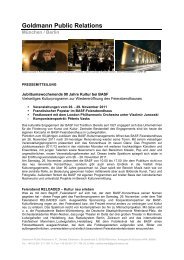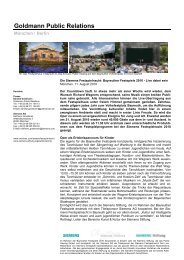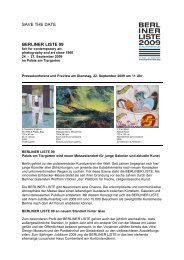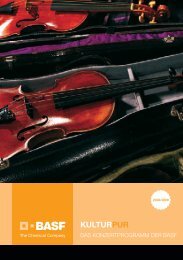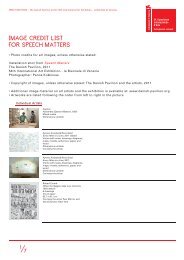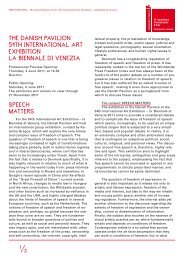Abonnez-vous à «Technikart» sur www.objetculte.fr
Abonnez-vous à «Technikart» sur www.objetculte.fr
Abonnez-vous à «Technikart» sur www.objetculte.fr
You also want an ePaper? Increase the reach of your titles
YUMPU automatically turns print PDFs into web optimized ePapers that Google loves.
vip talks<br />
Alain<br />
Servais<br />
Quelle a été la première photographie que <strong>vous</strong> ayez acquise ?<br />
What were the first photographic works you bought?<br />
Il s’agit d’une des premières photos de Nan Goldin et d’un<br />
des premiers clichés d’Andres Serrano qui se nomme Antonio<br />
and Ulrike. One of the first photographs by Nan Goldin, and one of<br />
the first by Andres Serrano, which was called Antonio and Ulrike.<br />
Faites-<strong>vous</strong> une différence entre art contemporain<br />
et photographie ? Do you see a difference between<br />
contemporary art and photography?<br />
Oui et non. La photographie revêt sa propre histoire et ses<br />
caractéristiques dont la plus importante est la reproductibilité<br />
mais aussi ses sous courants : la photographie documentaire<br />
et la photographie plasticienne. Je fais la différence entre les<br />
deux en me demandant ce qui me touche dans l’image devant<br />
moi : le sujet (qui renvoie <strong>à</strong> la photo documentaire) ou le<br />
traitement du sujet par le photographe (<strong>à</strong> la photo plasticienne).<br />
La photographie, qui fait aujourd’hui partie intégrante de l’art<br />
contemporain dans sa partie plasticienne, m’intéresse le plus.<br />
Yes and no. Photography has its own history and characteristics,<br />
the most important being its reproductibility, but also its different<br />
arms: documentary photography and art photography. I differentiate<br />
between the two by asking myself what touches me in the image<br />
in <strong>fr</strong>ont of me: the subject (which comes back to documentary<br />
photography), or the treatment of the subject by the photographer<br />
(art photography)? Photography today forms an integral part<br />
of contemporary art in terms of its artistry side, which is what<br />
interests me the most.<br />
10 \ Technikart fotofever \ Oct 2012<br />
En tant que collectionneur, en quoi est-ce bien pour <strong>vous</strong><br />
de visiter des foires spécialisées en photographie ?<br />
As a collector, what do you get <strong>fr</strong>om fairs that specialise<br />
in photography?<br />
Afin de rencontrer les acteurs du secteur (galeristes,<br />
curateurs, artistes, journalistes,...) et éventuellement faire des<br />
découvertes même si ce dernier point devient de plus en plus<br />
rare dans les foires actuelles. Mon lieu privilégié de découvertes<br />
est les Rencontres de la Photographie <strong>à</strong> Arles. It allows me to<br />
meet the players in this sector (gallery owners, curators, artists,<br />
journalists…) and potentially to make discoveries, even if the latter<br />
are becoming increasingly rare at today’s fairs. My favorite place for<br />
discoveries is the Rencontres de la Photographie in Arles.<br />
Etes-<strong>vous</strong> particulièrement sensible aux tirages : nombre,<br />
époque… ? Does the number or the age of the prints make<br />
a difference to you?<br />
Je suis sensible au fait que le tirage ait été réalisé sous la<br />
supervision du photographe. La taille de l’édition n’est pas<br />
très importante pour moi car je favorise la distribution large de<br />
l’image. It is important to me that the print has been executed under<br />
the supervision of the photographer. The size of the edition isn’t very<br />
important for me because I favor a wide distribution of the image.<br />
Quel a été votre dernier coup de cœur en photo ? What is your<br />
latest passion in photography?<br />
L’incroyable exposition-manifeste intitulée “From here on”<br />
présentée <strong>à</strong> Arles en 2011 et actuellement au musée de<br />
la photographie d’Anvers. The incredible exhibition-happening<br />
entitled ‘From here on’ presented at Arles in 2011, and currently at<br />
Antwerp photography museum.<br />
Quel artiste conseilleriez-<strong>vous</strong> de regarder <strong>à</strong> de jeunes<br />
collectionneurs ? What artists would you recommend young<br />
collectors to take a look at?<br />
Isabelle le Minh, Corinne Vionnet, Jon Rafman, Daniel<br />
Gordon et Moira Ricci. Isabelle le Minh, Corinne Vionnet,<br />
Jon Rafman, Daniel Gordon, and Moira Ricci.<br />
Qu’est-ce que la photographie aujourd’hui ?<br />
Six collectionneurs répondent…<br />
◆ What is photography today?<br />
Six collectors answer…<br />
Nan Goldin, «James waiting<br />
for fitting at Jean Colonna<br />
showroom» Paris (1995).<br />
Renaud Auguste-Dormeuil,<br />
«#40» Les collectionneurs,<br />
Galerie Fabienne Leclerc<br />
/ In Situ Paris.<br />
Frédéric<br />
de Goldschmidt<br />
Comment <strong>vous</strong> est venu le virus de<br />
la collection ? How did you get bitten by the<br />
collecting bug?<br />
Le virus devait être tapi quelque part dans<br />
mes cellules souches. Ma grand-mère en effet<br />
était collectionneuse, et m’emmenait, quand<br />
j’étais enfant, dans les musées. J’ai décidé, fin<br />
2008, de consacrer du temps pendant un an<br />
pour sillonner galeries, foires, etc. Un an plus<br />
tard, alors que mes murs étaient déj<strong>à</strong> remplis,<br />
j’ai acheté, pendant une FIAC, une toile de<br />
l’allemand Daniel Lergon, que je savais ne<br />
pouvoir accrocher. C’est l<strong>à</strong> que les bornes ont<br />
été <strong>fr</strong>anchies, et que, comme disait l’humoriste,<br />
il n’y a plus eu de limites... J’ai su, malgré<br />
l’as<strong>sur</strong>ance donnée <strong>à</strong> ma famille et <strong>à</strong> mes proches<br />
que tout allait bien, que le virus ne pouvait<br />
plus être enrayé. Je fais désormais “tourner” les<br />
œuvres en changeant l’accrochage, chez moi et<br />
dans les trois espaces que j’ai provisoirement<br />
annexés pour accrocher et faire partager mes<br />
découvertes, environ une fois par an. It must<br />
have been latent somewhere in my DNA. My<br />
grandmother was a collector, and she used to take<br />
me to museums as a child. At the end of 2008<br />
I decided to devote a year to hunting around in<br />
galleries, art fairs, etc. A year later, even though<br />
there was no more space on my walls, I bought a<br />
painting at the FIAC by the German artist Daniel<br />
Lergon, which I knew I wouldn’t be able to hang.<br />
At that point I overstepped the boundary and, as<br />
the wit Alphonse Allais said, there were no more<br />
limits… despite telling my family and <strong>fr</strong>iends that<br />
everything was fine, I knew I’d truly been bitten<br />
by the bug. Since then I have “revolved” the works<br />
by changing the hanging, at home and in the three<br />
spaces I have temporarily annexed for hanging<br />
and sharing my discoveries, about once a year.<br />
Quelle a été votre première pièce acquise ?<br />
What was the first piece you bought?<br />
La première pièce d’art contemporain<br />
achetée de façon réfléchie l’a été après une<br />
visite <strong>à</strong> la FIAC mais trois ans plus tôt, en<br />
2006. J’avais vu des œuvres d’un jeune artiste<br />
<strong>fr</strong>ançais, Benjamin Sabatier, <strong>sur</strong> le stand de la<br />
galerie Jérôme de Noirmont mais elles avaient<br />
toutes été vendues. J’ai demandé au galeriste<br />
s’il prévoyait une exposition prochainement<br />
et ai noté la date. Six mois plus tard, j’étais<br />
présent au tout début du vernissage et j’ai<br />
acheté une œuvre faite <strong>à</strong> partir de bacs <strong>à</strong> glaçons<br />
et de papier <strong>fr</strong>oissé. Ce côté “recyclage de<br />
matériaux” a d’ailleurs souvent empreint mes<br />
choix suivants. The first piece of contemporary<br />
art that I bought in a considered way was after a<br />
visit to the FIAC three years earlier, in 2006. I’d<br />
seen the works of a young French artist, Benjamin<br />
Sabatier, on the Jérôme de Noirmont gallery stand<br />
but they were all sold. I asked the gallery owner<br />
if he was planning an exhibition soon and I wrote<br />
down the date. Six months later I was there at the<br />
very beginning of the preview party and I bought<br />
a work done with ice-cube trays and crumpled<br />
paper. This “recycling of materials” aspect has<br />
often colored my choices since then.<br />
Comment êtes-<strong>vous</strong> venu <strong>à</strong> la photographie ?<br />
How did you get into photography?<br />
Avant mon “année sabbatique”, j’avais déj<strong>à</strong><br />
acheté quelques photos au fil de rencontres<br />
(des photos peintes d’Elizabeth Lennard,<br />
une amie américaine qui m’est très chère ;<br />
le revers d’un socle d’objet du Louvre par<br />
le parisien Raphaël Chipault avec qui j’avais<br />
participé <strong>à</strong> des ateliers d’ethnographie<br />
contemporaine pour jeunes publics ou une<br />
série de radiographies de flacons de mon<br />
ami liégeois Aniceto Exposito Lopez). Mes<br />
premiers achats de photo ont commencé par<br />
être plutôt historiques, et plutôt dans des<br />
ventes aux enchères : Berenice Abbott, les<br />
Becher, Henri Cartier-Bresson ou Walker<br />
Evans. Puis <strong>à</strong> Paris Photo, plusieurs planches<br />
de deux photographes de Rotterdam, Ari<br />
Versluis et Ellie Uyttenbroek, de la série<br />
Exactitudes <strong>sur</strong> les pratiques vestimentaires de<br />
différentes tribus modernes, qui questionnent<br />
l’appartenance au groupe et l’individualité.<br />
C’est sans doute mon cursus d’ethnologie qui<br />
m’avait fait apprécier ces anthropologues du<br />
monde contemporain. Before my “sabbatical<br />
year” I had already bought a few photographs<br />
through various encounters: the painted<br />
photographs of Elizabeth Lennard, a dear<br />
American <strong>fr</strong>iend; the reverse of an object plinth<br />
in the Louvre by the Parisian Raphaël Chipault,<br />
with whom I had worked on contemporary<br />
ethnography workshops for young visitors;<br />
or a series of X-rays of bottles by my <strong>fr</strong>iend<br />
Aniceto Exposito Lopez <strong>fr</strong>om Liège. My first<br />
photographic purchases started out as mainly<br />
historical, and bought at auction: Berenice<br />
Abbott, the Bechers, Henri Cartier-Bresson, or<br />
Walker Evans. Then, at Paris Photo, several<br />
contact sheets by two Rotterdam photographers,<br />
Ari Versluis and Ellie Uyttenbroek, <strong>fr</strong>om the<br />
series Exactitudes on the sartorial practices of<br />
different modern tribes, which question belonging<br />
to a group and individuality. I’m <strong>sur</strong>e it is my<br />
career as an ethnologist that made me appreciate<br />
these anthropologists of the contemporary world.<br />
Y a-t-il une période que <strong>vous</strong> préférez ? Do<br />
you have you a favorite period?<br />
En tant qu’amateur, je m’intéresse <strong>à</strong> des<br />
styles de photo différents et visite aussi bien<br />
les expositions d’artistes historiques que<br />
contemporains, au fil de la programmation des<br />
institutions. J’ai une tendresse particulière<br />
pour les photographes humanistes de la France<br />
d’après-guerre, mais n’en possède quasiment<br />
pas. En tant que collectionneur, je me concentre<br />
plutôt, quelle que soit la discipline artistique,<br />
<strong>sur</strong> la création récente. J’adore les artistes<br />
un peu “<strong>fr</strong>oids”, au travail assez visuel et<br />
construit comme Louise Lawler ou Hiroshi<br />
Sugimoto, mais aussi des portraitistes plus<br />
décalés comme Walter Pfeiffer et Wolfgang<br />
Tillmans. J’aime bien aussi la représentation<br />
de lieux originaux : un aéroport portugais par<br />
Edgar Martins, le détail d’une rue de New York<br />
par Viktoria Binschtok ou une horloge repérée<br />
par Yves Marchand et Romain Mef<strong>fr</strong>e dans un<br />
immeuble ravagé par le feu. As an enthusiast,<br />
I’m interested in different styles of photography<br />
and visit exhibitions of historical artists as well<br />
as contemporary ones, depending on what the<br />
different institutions have on their program. I’m<br />
particularly fond of the humanist photographers<br />
of Post-War France, but I have hardly any in my<br />
collection. As a collector, I tend to concentrate on<br />
recent creations, whatever the artistic discipline. I<br />
love the artists that are considered rather “cold”,<br />
with a very visual and constructed work like<br />
Louise Lawler or Hiroshi Sugimoto, but also the<br />
more off-beat portraitists like Walter Pfeiffer and<br />
Wolfgang Tillmans. I also like the representation<br />
of original places: a Portuguese airport by Edgar<br />
Martins, the detail of a street in New York by<br />
Viktoria Binschtok or a clock spotted by Yves<br />
Marchand and Romain Mef<strong>fr</strong>e in a building<br />
ravaged by fire.<br />
Quel artiste conseilleriez-<strong>vous</strong> de regarder<br />
<strong>à</strong> de jeunes collectionneurs ? What artist<br />
would you recommend young collectors to<br />
take a look at?<br />
Il y avait <strong>à</strong> Volta, une foire “off” de Bâle, un<br />
artiste danois, Adam Jeppesen qui faisait des<br />
séries aux tirages limités dans le temps et non<br />
dans le nombre, permettant ainsi au galeriste de<br />
proposer des prix raisonnables. Je trouve en effet<br />
que la photo est parfois chère quand on prend<br />
en compte le nombre d’exemplaires tirés. Je<br />
conseillerais donc <strong>à</strong> un jeune collectionneur de<br />
chercher des beaux tirages d’artistes renommés<br />
dans des tirages élevés (mon Sugimoto fait<br />
partie d’un portfolio édité <strong>à</strong> 500 exemplaires et<br />
m’a couté moins de 500 euros). Ou de se laisser<br />
entrainer par un coup de cœur personnel au fil<br />
des balades et des rencontres. Un bel endroit<br />
pour trouver des pièces historiques de qualité<br />
(même si le nombre d’exemplaires tirés n’est pas<br />
toujours précisément connu) est la Maison Revue<br />
Noire, <strong>à</strong> Paris, qui propose des photos d’artistes<br />
a<strong>fr</strong>icains déj<strong>à</strong> historiques mais aussi des œuvres<br />
de plasticiens contemporains de talent, comme<br />
Joël Andrianomearisoa, qui aborde <strong>à</strong> travers<br />
différents médias, la photographie mais aussi le<br />
papier, le tissu ou la performance, <strong>à</strong> travers les<br />
thèmes du désir et du temps qui passent. Il utilise<br />
la photo pour ce qu’elle permet d’apporter si<br />
bien par rapport <strong>à</strong> d’autres pratiques artistiques<br />
: faire passer l’émotion de façon très directe. In<br />
Volta, a <strong>fr</strong>inge fair at Basel, there was a Danish<br />
artist, Adam Jeppesen, who was doing print<br />
series limited in time and not in number, thereby<br />
allowing the gallery owner to offer reasonable<br />
prices. I sometimes find photography expensive<br />
in view of the number of examples printed. I<br />
would therefore advise a young collector to look<br />
for attractive prints by known artists in relatively<br />
large editions (my Sugimoto was part of a portfolio<br />
of 500 examples and cost me less than 500 euros).<br />
Or to let themselves be carried away by something<br />
that moves them personally as they wander around<br />
and have encounters. A good place to find quality<br />
historical pieces – even if the number of prints is<br />
not exactly known – is the Maison Revue Noire<br />
in Paris, which offers photographs by A<strong>fr</strong>ican<br />
artists that are already considered historical, as<br />
well as works by talented contemporary artists<br />
like Joël Andrianomearisoa. This artist works<br />
in different media – photography but also paper,<br />
fabric or performance – on the themes of desire and<br />
the passage of time. He uses photography because<br />
it allows him to convey things better than other<br />
artistic techniques: to express emotion in a very<br />
direct way.<br />
Quel a été votre dernier coup de cœur en<br />
photo ? What is your latest passion in terms<br />
of photography?<br />
Je suis depuis deux ou trois ans un<br />
photographe israélien de Los Angeles, Elad<br />
Lassry, mais n’avais pas pu trouver la photo<br />
qui était en même temps disponible et <strong>à</strong> mon<br />
goût. A la foire de Bâle au mois de juin, j’ai<br />
trouvé une photo étrange représentant des<br />
couverts comme en lévitation dans un intérieur<br />
déstructuré. La représentation, très esthétique,<br />
d’objets triviaux et le jeu <strong>sur</strong> les couleurs (le<br />
noir et le blanc, mes préférées même si Elad<br />
Lassry privilégie généralement les tons plus<br />
vifs) m’ont séduit. J’ai appris par la suite que<br />
l’artiste photographie <strong>sur</strong> une table miroir qui<br />
déforme les objets, permet les reflets (un thème<br />
qui m’attire souvent) et laisse ainsi apparaître<br />
<strong>sur</strong> cette photo les murs de son studio, ce<br />
qui donne un côté personnel <strong>à</strong> un travail a<br />
priori distancié. A noter aussi le cadre choisi<br />
par l’artiste (en métal argenté) qui fait partie<br />
intégrante de l’œuvre. For two or three years<br />
now I’ve been following an Israeli photogapher<br />
who lives in Los Angeles, Elad Lassry, but I<br />
hadn’t been able to find the photograph that was<br />
both available and my taste. At the Basel fair<br />
in June I found a strange photograph showing<br />
place settings that seemed to be levitating in<br />
a deconstructed interior. The very aesthetic<br />
representation of trivial objects and the play<br />
of colors (black and white, my favourite even<br />
if Elad Lassry generally prefers brighter tones)<br />
attracted me. I learnt afterwards that the artist<br />
photographs on a mirror table, which distorts<br />
the objects, allows reflections (a theme that often<br />
attracts me), and lets the walls of his studio<br />
appear on this photo, which gives a personal side<br />
to an approach that is generally objective. It is<br />
also worth mentioning the <strong>fr</strong>ame chosen by the<br />
artist, in silvered metal, which forms an integral<br />
part of the work.<br />
Technikart fotofever \ Oct 2012 \ 11


